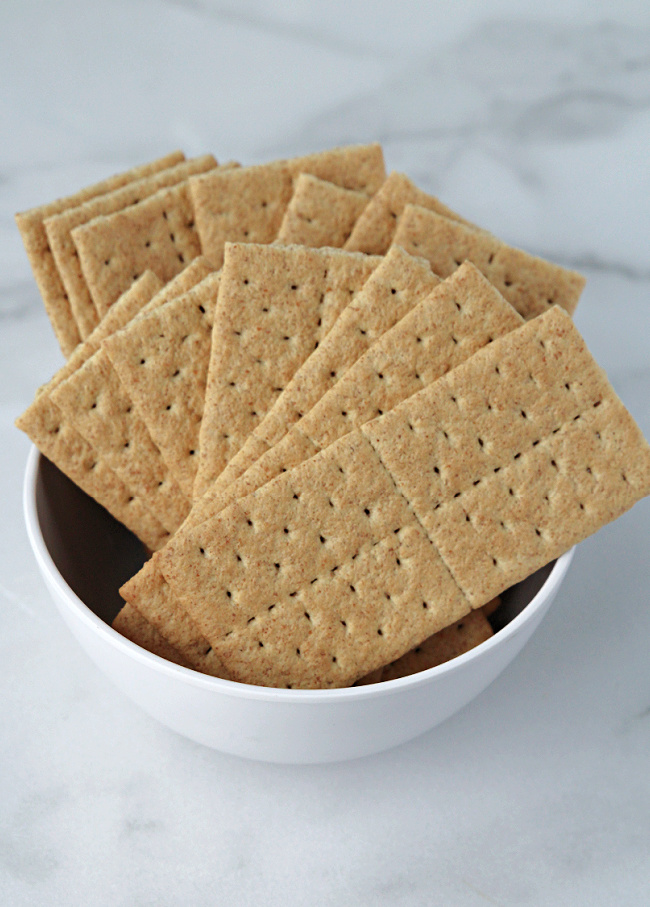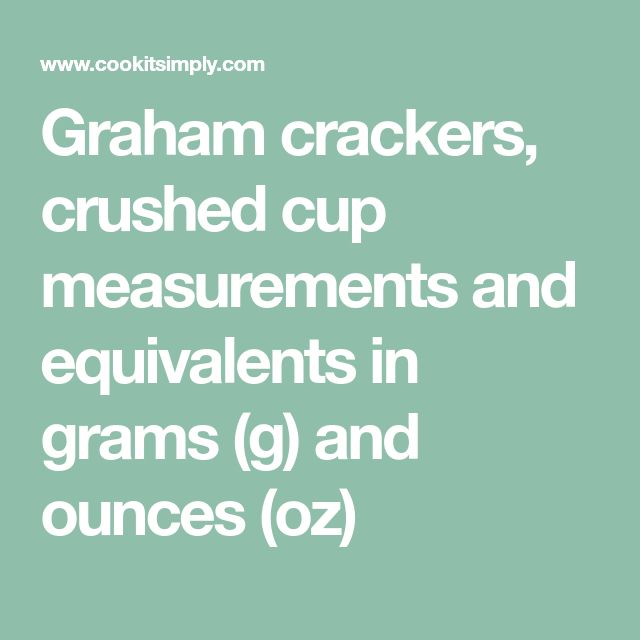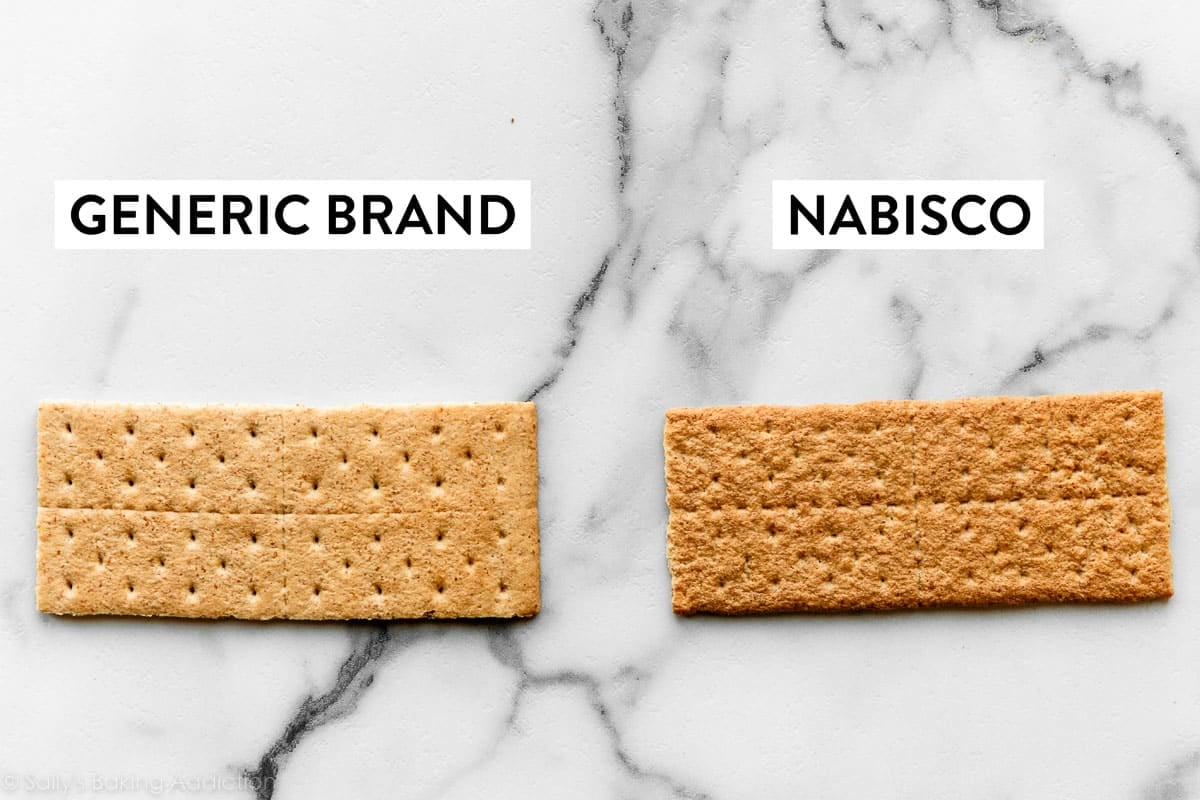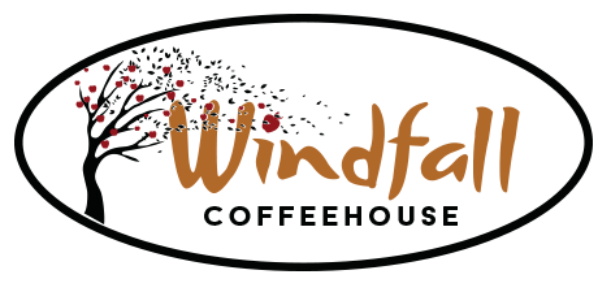
Introduction To Graham Crackers
Graham crackers are a type of sweet and savory cracker that is commonly used in baking and as a base for desserts like pie crusts and cheesecake. They are made from a combination of whole wheat flour, sugar, and flavorings such as cinnamon. Graham crackers were invented by Sylvester Graham in the early 19th century as a part of his dietary reform movement, which promoted healthy and natural foods.
Graham crackers have a distinctive taste and texture. They are slightly sweet with a hint of cinnamon and have a crisp, crunchy texture. They are often enjoyed as a snack on their own, but they are also commonly used in recipes as an ingredient.
Graham crackers are versatile and can be used in a variety of recipes. They can be crushed and mixed with melted butter to make a delicious crust for pies and cheesecakes. They can also be used as a topping for desserts like ice cream or yogurt. Additionally, graham crackers can be used to make s’mores, a popular campfire treat.
Importance Of Accurate Baking Conversions
Accurate baking conversions are crucial when it comes to achieving the desired results in baking. Baking is a science that requires precise measurements and ratios of ingredients. Without accurate conversions, the texture, taste, and appearance of baked goods can be affected.
Converting measurements from one unit to another is necessary when following recipes from different sources or when adapting recipes to fit specific dietary needs or preferences. Common conversions include converting between volume measurements (cups, tablespoons, teaspoons) and weight measurements (grams, ounces), as well as converting between different measurement systems (metric and imperial).
Using accurate baking conversions ensures that the right amount of each ingredient is used. Too much or too little of certain ingredients can result in a baking disaster. For example, using too much baking powder can cause a cake to rise too much and then collapse, while using too little can result in a dense and flat cake.
In conclusion, understanding the basics of graham crackers and the importance of accurate baking conversions is essential for successful baking. Graham crackers are a versatile ingredient that can be used in various recipes, while accurate conversions are necessary to ensure the desired outcome of baked goods.
Understanding Baking Measurements
Different Units Of Measurement For Baking
Baking requires precise measurements of ingredients to achieve the desired results. There are different units of measurement commonly used in baking:
- Volume measurements: These include cups, tablespoons, and teaspoons. Volume measurements are used for ingredients like flour, sugar, and liquids.
- Weight measurements: These include grams and ounces. Weight measurements are used for ingredients like butter and chocolate.
- Metric and imperial systems: Baking recipes can use different measurement systems, so it’s important to understand conversions between the metric and imperial systems.
Importance Of Using Standardized Measurements
Accurate baking conversions are crucial to ensure consistent and reliable results in baking. Here’s why using standardized measurements is important:
- Consistency: Using standardized measurements allows for consistency in recipes, ensuring that the same amount of each ingredient is used every time. This helps to maintain the taste, texture, and appearance of baked goods.
- Precision: Baking is a science and requires precise measurements. Using standardized measurements helps to achieve the desired balance of ingredients, ensuring that the right amount is used for optimal results. This is especially important for delicate recipes like pastries and cakes.
- Adaptation: Standardized measurements make it easier to adapt recipes to fit specific dietary needs or preferences. Converting between units of measurement allows for flexibility when using different recipes or ingredient substitutions.
In conclusion, understanding different units of measurement in baking and the importance of using standardized measurements is essential for successful baking. Accurate conversions ensure that the right amount of each ingredient is used, leading to consistent and delicious results in baked goods.
The Role Of Cup Measurements In Baking
Understanding The Cup Measurement In Baking
Baking enthusiasts know that precision is key when it comes to achieving the perfect baked goods. One of the most commonly used units of measurement in baking is the cup. Understanding how to accurately measure ingredients using cups is essential for consistent and successful results.
Using Cups For Consistent Results In Baking
When it comes to baking, using standardized measurements like cups ensures consistency in recipes. Here are a few reasons why cups play an important role in achieving consistent results:
- Ease of Use: Cups provide a convenient and straightforward way to measure ingredients. Most recipes specify measurements in cups, making it easy for home bakers to follow along.
- Ideal for Dry Ingredients: Cups are especially useful when measuring dry ingredients like flour and sugar. Using a measuring cup allows you to level off the ingredients, ensuring accuracy and consistency.
- No Conversion Necessary: Unlike weight measurements that may require conversions, cup measurements are commonly used in baking recipes. This eliminates the need for converting between different units of measurement and simplifies the baking process.
- Flexibility in Adaptation: Cup measurements offer flexibility when it comes to adapting recipes. If you need to adjust the serving size or make substitutions, using cups makes it easier to scale the recipe up or down while maintaining the correct proportions.
- Consistency in Taste and Texture: Using cups to measure ingredients ensures that you are consistently adding the same amount of each ingredient to your recipe. This helps maintain the desired taste and texture of your baked goods.
In conclusion, understanding the role of cup measurements in baking is essential for achieving consistent and reliable results. Cups provide a user-friendly and practical method for measuring ingredients, allowing for precision and consistency in your baked goodies. Whether you are a novice baker or an experienced one, mastering cup measurements can take your baking endeavors to new heights.

The Role Of Cup Measurements In Baking
Understanding The Cup Measurement In Baking
Baking enthusiasts know that precision is key to achieving perfect baked goods. One commonly used unit of measurement in baking is the cup. Mastering accurate measurement using cups is crucial for consistent and successful results.
Using Cups For Consistent Results In Baking
Standardized measurements like cups ensure consistency in baking recipes. Here are a few reasons why cups play an important role:
- Ease of Use: Cups provide a convenient and straightforward way to measure ingredients. Most recipes specify measurements in cups, making it easy to follow along.
- Ideal for Dry Ingredients: Cups are especially useful when measuring dry ingredients like flour and sugar. Using a measuring cup allows you to level off the ingredients, ensuring accuracy and consistency.
- No Conversion Necessary: Cup measurements are commonly used in baking recipes, eliminating the need for conversions between different units of measurement. This simplifies the baking process.
- Flexibility in Adaptation: Cup measurements offer flexibility in adapting recipes. Whether adjusting serving sizes or making substitutions, using cups makes it easier to scale the recipe while maintaining correct proportions.
- Consistency in Taste and Texture: Using cups ensures consistent amounts of each ingredient, resulting in the desired taste and texture of your baked goods.
Estimating Graham Crackers In Cups
Average Weight Of Graham Crackers
Before converting graham crackers into cups, it’s important to have a general idea of their average weight. On average, a graham cracker weighs around 14 grams. However, individual brands may have slight variations in weight.
Converting Graham Crackers Into Cups
To convert graham crackers into cups, you need to consider the weight of a typical cracker and the desired cup measurement. Here’s a simple conversion guide:
| Number of Graham Crackers | Cup Measurement |
|---|---|
| 1 graham cracker | approximately 0.067 cups |
| 4 graham crackers | approximately 0.27 cups |
| 8 graham crackers | approximately 0.54 cups |
| 12 graham crackers | approximately 0.81 cups |
| 16 graham crackers | approximately 1.08 cups |
These conversions are approximate and can vary based on the size and weight of the graham crackers you have. It’s always a good idea to measure with a measuring cup for accuracy.
Overall, understanding the role of cup measurements in baking is essential for achieving consistent and reliable results. Cups provide a user-friendly and practical method for measuring ingredients, ensuring precision and consistency in your baked goods. Whether you are a novice or experienced baker, mastering cup measurements will elevate your baking endeavors.
Calculating the Number of Graham Crackers in a Cup
Determining the Size of Graham Crackers
To accurately calculate the number of graham crackers in a cup, it’s important to determine the size and weight of the crackers. On average, a standard graham cracker weighs around 14 grams. However, it’s essential to note that different brands might have slight variations in weight.
Total Number of Graham Crackers in a Cup
To convert the number of graham crackers into cups, it is important to consider the weight of a typical cracker and the desired cup measurement. The following table provides a simple conversion guide:
| Number of Graham Crackers | Cup Measurement |
|---|---|
| 1 graham cracker | approximately 0.067 cups |
| 4 graham crackers | approximately 0.27 cups |
| 8 graham crackers | approximately 0.54 cups |
| 12 graham crackers | approximately 0.81 cups |
| 16 graham crackers | approximately 1.08 cups |
Please keep in mind that these conversions are approximate and may vary depending on the size and weight of the graham crackers you are using. For optimal accuracy, it is recommended to measure the crackers with a measuring cup.
Understanding the role of cup measurements in baking is crucial for obtaining consistent and reliable results. Cups provide a user-friendly and practical method for measuring ingredients accurately, ensuring precision and consistency in your baked goods. Whether you are an amateur or a seasoned baker, mastering cup measurements will enhance your baking endeavors.
Practical Baking Tips And Tricks
Substitutions For Graham Crackers In Recipes
When you don’t have graham crackers on hand or need an alternative, there are a few substitutes you can use in your recipes. Some common options include:
- Digestive biscuits: These biscuits have a similar texture and flavor to graham crackers and can be used as a substitute in recipes like pie crusts or cheesecake bases.
- Shortbread cookies: Shortbread cookies can provide a buttery and crumbly texture that works well as a graham cracker replacement in certain recipes.
- Vanilla wafers: These cookies have a mild flavor and a slightly different texture than graham crackers but can work as a substitute in some dessert recipes.
When using substitutes, keep in mind that there may be slight variations in taste and texture compared to using graham crackers. It’s always best to test the recipe with the substitute beforehand if possible.
Adjusting Measurements For Recipe Variations
Sometimes you may come across a recipe that calls for a different measurement unit or requires adjustments based on specific variations. Here are a few tips for adjusting measurements:
- Converting between cups and grams: If a recipe provides measurements in cups, but you prefer to work with grams, there are conversion charts available online to guide you. Keep in mind that the weight of a cup can vary for different ingredients, so it’s best to use a scale for precise measurements.
- Scaling down or up: When you want to adjust a recipe for a different yield, it’s important to maintain the right proportions. Consider using a recipe calculator or manually scaling the ingredients down or up based on the desired serving size.
- Substituting one ingredient with another: If you need to replace an ingredient in a recipe due to dietary restrictions or personal preference, make sure to research alternatives that have similar properties and adjust the quantity accordingly.
Remember, when making any adjustments or substitutions in a recipe, it’s always a good idea to keep notes and make small test batches to ensure the desired results.
By following these practical baking tips and tricks, you can confidently experiment with recipes, make necessary substitutions, and adjust measurements as needed to create delicious baked goods every time.

Recipes That Use Graham Crackers
Popular Recipes Utilizing Graham Crackers
Graham crackers are a popular ingredient in many delicious dessert recipes. Here are a few well-loved recipes that use graham crackers:
Classic S’mores:
A timeless favorite, s’mores consist of graham crackers, chocolate, and marshmallows. Simply sandwich a piece of chocolate and a roasted marshmallow between two graham crackers for a delightful treat.
Cheesecake:
A graham cracker crust is a common base for cheesecake. The crumbly texture and slightly sweet flavor of the graham crackers complement the creamy and tangy filling of the cheesecake perfectly.
Icebox Cake:
Graham crackers are layered with whipped cream and sometimes fruit to create a delicious and easy-to-make no-bake icebox cake. The graham crackers soften and become cake-like after being refrigerated, resulting in a delightful dessert.
Tips For Incorporating Graham Crackers Into Desserts
If you want to experiment with using graham crackers in your own dessert creations, here are some tips to keep in mind:
- Crushing graham crackers: To make a graham cracker crust or crumb topping, simply crush the graham crackers by placing them in a bag and using a rolling pin to create crumbs. Alternatively, you can use a food processor for a finer texture.
- Layering graham crackers: When making layered desserts like parfaits or trifles, layer the crushed graham crackers with other ingredients like cream, pudding, or fruit for added texture and flavor.
- Decorating with graham crackers: Graham crackers can be used to create decorative elements for desserts. For example, you can use them to make a decorative lattice on top of pies or use them as a base for building gingerbread houses.
By incorporating graham crackers into your desserts, you can add a delicious crunch, subtle sweetness, and nostalgic flavor to your creations.
Conclusion
Summarizing The Importance Of Accurate Baking Conversions
Accurate baking conversions are crucial for achieving the desired results in your baked goods. Failing to accurately measure and convert ingredients can lead to an imbalanced recipe and end up affecting the taste, texture, and overall quality of your baked goods.
It is important to pay attention to the specific measurements and conversions mentioned in recipes to ensure that your baked goods turn out as intended. Understanding and following baking conversions can help you become a better baker and produce consistent and delicious results.
Final Thoughts On Graham Crackers Measurements In Cups
Graham crackers are a versatile ingredient commonly used in baking, especially for making crusts. By knowing the approximate measurements and conversions, you can easily substitute graham cracker sheets with crushed graham crackers in recipes and achieve the desired results.
Whether you are making a graham cracker crust for a pie or using crushed graham crackers as a topping, it is helpful to have a general idea of the measurements to use. Remember to adjust the quantity based on your personal preference and the desired thickness of the crust.
So the next time you come across a recipe that calls for graham crackers, you can confidently make substitutions with crushed graham crackers, knowing that the flavor will remain the same while adding your unique touch to the dish.
Frequently Asked Questions
How Many Graham Crackers in a Cup: Baking Conversion Query
Q: How many graham crackers are there in one cup?
A: The number of graham crackers in one cup can vary based on the size and thickness of the crackers. On average, there are approximately 7 to 10 whole graham crackers in one cup, depending on their size.
Q: Can I use crushed graham crackers instead of whole crackers in a recipe?
A: Yes, you can definitely use crushed graham crackers as a substitute for whole crackers in recipes. If a recipe calls for a specific number of whole graham crackers, you can measure the equivalent amount in cups of crushed crackers. The ratio usually falls around 1 ½ to 2 cups of crushed graham crackers per every 10 whole crackers.
Q: What if I don’t have a measuring cup? How can I estimate the number of graham crackers in a cup?
A: If you don’t have a measuring cup on hand, you can still roughly estimate the number of graham crackers in a cup. You can take a handful of crackers and count them, then repeat the process until you have what would amount to a cup. Keep in mind that this method may not be as precise as using a measuring cup, but it can provide a similar result.
Q: Do graham cracker sheets count as one whole cracker?
A: Yes, graham cracker sheets usually count as one whole cracker. These sheets consist of perforated squares or rectangles, and most recipes would consider one sheet as one cracker. If a recipe specifically mentions the number of graham cracker sheets required, you do not need to break them into individual pieces.
Q: Can I break graham crackers into smaller pieces to fit a measuring cup?
A: Yes, you can break graham crackers into smaller pieces to fit a measuring cup if needed. Using a clean, sealed plastic bag and a rolling pin or a food processor, you can crush the crackers into smaller, more manageable pieces. Once crushed, you can then measure the desired amount using a measuring cup.
Q: How can I ensure the accurate measurement of graham crackers?
A: To ensure the accurate measurement of graham crackers, it’s recommended to use a measuring cup specifically designed for dry ingredients. Make sure to level off the cup by removing any excess cracker pieces above the rim. This will help you achieve a more precise measurement for your recipe.
Q: Are the measurements for graham crackers different in different countries?
A: The measurement of graham crackers in different countries can vary slightly due to variations in manufacturing and packaging. However, the general ratio and average number of crackers in a cup remain relatively consistent. It is always advisable to check the specific brand or packaging of graham crackers you are using for more precise measurements.
Conversion Table: Graham Crackers to Cups
| Number of Graham Crackers | Cups |
|---|---|
| 5 | 1/2 |
| 10 | 1 |
| 15 | 1 1/2 |
| 20 | 2 |
| 25 | 2 1/2 |
| 30 | 3 |
| 35 | 3 1/2 |
| 40 | 4 |
| 45 | 4 1/2 |
| 50 | 5 |
Please note that these measurements are approximate and may vary based on the brand and size of the graham crackers used.

We are family-owned and operated. We love to serve coffee to our community that loves to drink it! We opened in December 2017 and are always expanding and evolving. We strive to offer a relaxing and comfortable gathering place for our customers. We not only serve delicious coffee but a full breakfast and lunch menu as well. You can also order ONLINE through our website or call ahead and pick it up right at our drive-thru window! We have a wide range of delicious baked goods, sweet treats, and a gift shop coming soon! Stop in and let us serve you!!